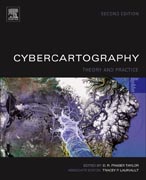
Developments in the Theory and Practice of Cybercartography: Applications and Indigenous Mapping
Taylor, D.R.F.
Lauriault, Tracey
Cybercartography is a new paradigm for maps and mapping in the information era. Defined as the organization, presentation, analysis and communication of spatially referenced information on a wide variety of topics of interest to society, cybercartography is presented in an interactive, dynamic, multisensory format with the use of multimedia and multimodal interfaces. Developments in the Theory and Practice of Cybercartography: Applications and Indigenous Mapping examines some of the recent developments in the theory and practice of cybercartography and the substantial changes which have taken place since the first edition published in 2005. It continues to examine the major elements of cybercartography and emphasizes the importance of interaction between theory and practice in developing a paradigm which moves beyond the concept of Geographic Information Systems and Geographical Information Science. The seven major elements of cybercartography outlined in the first edition have been supplemented by six key ideas and the definition of cybercartography has been extended and expanded. The new practice of mapping traditional knowledge in partnership with indigenous people has led to new theoretical understanding as well as innovative cybercartographic atlases. Featuring more than 90% new and revised content, this volume is a result of a multidisciplinary team effort and has benefited from the input of partners from government, industry and aboriginal non-governmental organizations. Highlights the relationship between cybercartography and critical geographyIncorporates several new cybercartographic atlases produced in cooperation with Inuit and First Nations groupsShowcases legal, ethical, consent and policy implications of mapping local and traditional knowledge Features an interactive companion web site containing links to related sites, additional color images and illustrations, plus important information to capture the dynamic and interactive elements of cybercartography: http://booksite.elsevier.com/9780444627131/ INDICE: Editor biographiesPreface1. Some Recent Developments in the Theory and Practice of Cybercartography: Applications in Indigenous Mapping: An Introduction2. From Cybercartography to the Paradigm of Geocybernetics: A Formal Perspective3. Geocybernetics as a Tool for the Development of Transdisciplinary Frameworks4. Cybercartography and Volunteered Geographic Information5. Exploring Web 2.0 and Participatory Software for Building Geo-located Narratives6. Tile-based Mapping with Opacity7. Advances in Location-based Services8. Inclusive Cartography: Theoretical and Applied Issues in Brazil9. The Nunaliit Cybercartographic Atlas Framework10. Interactive Audiovisual Design for Cartography: Survey, Prospects, and Example11. A Spatial Typology of Cinematographic Narratives12. Pilot Atlas of the Risk of Homelessness in Canada13. Mapping Views from the North: Cybercartographic Technology and Inuit Photographic Encounters14. The Creation of the Atlas of Inuit Sea Ice Use and Knowledge15. Kitikmeot Place Names Atlas16. The Gwich'in Atlas: place names, maps and narratives17. The Role of Experience in the Iterative Development of the Lake Huron Treaty Atlas18. Considerations for Informed Consent in the Context of Online, Interactive, Atlas Creation19. Cybercartography and Traditional Knowledge: Responding to Legal and Ethical Challenges20. Cybercartography for Education: The Application of Cybercartography to Teaching and Learning in Nunavut, Canada21. Archiving and Preserving Cybercartography22. Conclusion and the Future of CybercartographySubject Index
- ISBN: 978-0-444-62713-1
- Editorial: Elsevier Science
- Encuadernacion: Cartoné
- Páginas: 400
- Fecha Publicación: 10/02/2014
- Nº Volúmenes: 1
- Idioma: Inglés
